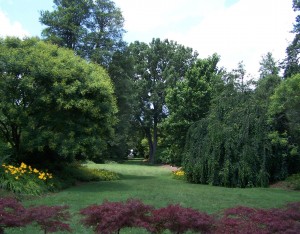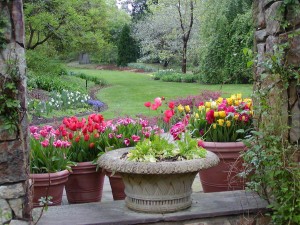Evolve With Your Garden
By Frank Robinson, President & CEO, & Lynn Kirk, PR Writer, Lewis Ginter Botanical Garden, reprinted with permission from the Richmond Times-Dispatch

The mature landscape, though beautiful, proves challenging for the inexperienced homeowner. Shown here is the Henry M. Flagler Garden, one of the more mature areas at Lewis Ginter Botanical Garden. Photo by Sue Liddell
Accept it, gardeners — change is the norm for gardens and landscapes. Nature alters growing conditions through ever-changing weather and seasons, as does the interaction of plants, insects and wildlife. Man creates modifications each time he clears trees to plant grass, introduces non-native species or adds hardscape features.
Another way our environs change is through the progressive maturing of plants and trees over time. From the day an area is cultivated and planted, it begins to alter. Over the years the maturing process may completely change a garden’s growing conditions – available sunlight, moisture, soil condition, temperature and space – and therefore the species of plants and trees that will thrive there. The savvy gardener not only recognizes the subtle changes of a maturing garden, he flexibly and knowledgeably adapts with them.
The Henry M. Flagler Garden at Lewis Ginter Botanical Garden exemplifies the gradual changes that a garden landscape experiences over time. In 1990, the area was treeless and sunny with open-ended vistas. Perennials were the hot topic of the day, and the botanical Garden staff appropriately planted an extensive collection of sun-loving, herbaceous perennials, accented by flowering shrubs and trees. Fast forward 20-plus years and the Flagler Garden has naturally transformed from a sun garden to primarily a shade garden as trees grew tall, expanded their leaf canopies and created areas of significant shade. Shrubs grew into mature widths and heights. Root systems became denser, causing competition for available nutrients and moisture. And while many of the Flagler Garden’s more than 1,200 different plants and trees adapted well to the gradual changes, others found it less ideal and declined. Horticulturists are now reworking this mature garden, and their tips may benefit homeowners who are dealing with similar situations.
Staff is selectively pruning large trees’ lower limbs to increase available sunlight and improve air circulation. Increased understory light avoids plant “legginess,” as well as lopsidedness caused by branches stretching toward the light needed for growth. With more light and air flow, moisture remains on leaves of understory plants for shorter time periods, reducing the risk and spread of disease. In other places, the horticulturists are transplanting sun-loving plants or repositioning plant beds to take advantage of existing sunlight. 
Initially, the Flagler Garden was densely planted with small nursery stock for immediate impact. Now, with maturing specimens, plants are being thinned to provide ideal space for their current size and long-term health. Less density reduces habitats for voles and other garden pests, as well.
When plant replacements are necessary, staff follows the “right plant – right place” practice, which in this case means transitioning to shade-loving species. They also seek to introduce natives and native hybrids, often more adapted to our climate. Organic materials are being used to improve soil structure and quality, and appropriate pH spurs the intake of natural nutrients. Additionally, “useless turf” will be reduced to increase display areas.
Rather than fighting change in the garden, Lewis Ginter Botanical Garden recommends embracing it. Try to understand the mature garden’s natural processes, take appropriate steps and then enjoy your rejuvenated landscape.
Editor’s Note: This article first published in the Richmond Times-Dispatch, in May 2012.